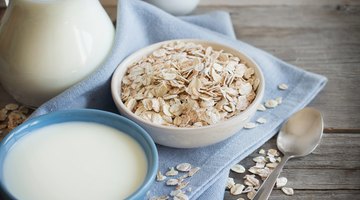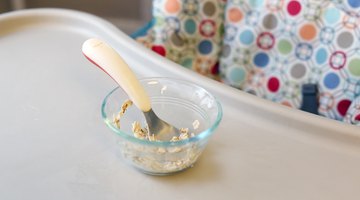How to Get Toddler to Drink Milk
Tips for Transitioning Your Toddler to Cow's Milk
Toddlers need about 700 milligrams of calcium per day, and milk is the perfect way to meet that daily requirement. But what do you do when your tot refuses milk or has trouble transitioning from formula or breast milk? Getting creative with your approach encourages your little one to drink up and get the calcium, vitamin D and other nutrients he needs.
When to Transition to Cow's Milk

Hemp Milk vs. Oat Milk for Toddlers
Learn More
The transition to cow's milk takes place around your baby's first birthday. Before 12 months, babies aren't quite ready to digest cow's milk, and it doesn't have the nutrients your little one needs. By 12 months, she should get more of her nutrition from solid food. You can stop formula after transitioning to cow's milk. Your baby may prefer to wean slowly. Continue breastfeeding as long as you want after you start cow's milk.
Tips for Making the Transition
Before you move to cow's milk, make sure your little one has a solid eating routine that includes a wide variety of healthy foods. While milk provides key nutrients, it doesn't offer the varied nutrition your baby gets from breast milk or formula. Having good eating habits in place ensures your tot still receives the nutrition she needs.
If your child doesn't like cow's milk, make the transition slowly. Instead of taking away breast milk or formula, add cow's milk at snack time or mealtime. He still gets the familiar option, but he's also exposed to the new drink. If he refuses the milk completely, mix in a little with formula or expressed breast milk. Slowly change the ratios, so you're gradually putting more cow's milk and less formula or breast milk in his cup.
Getting Your Toddler to Drink Milk From a Cup

How Much Milk for a 1-Year-Old
Learn More
Haven't made the switch from bottles to cups? Now's the perfect time to do it. She's drinking something new, so why not give her a new way to drink it, too? Most kids are ready for a cup by around 12 to 18 months.
Choose a few different styles of sippy cups in case your little one is picky about it. If she refuses one, try another style. Offer the cup at mealtime. Initially, you can hold on to the bottles for some feedings. Slowly transition to the cup for all feedings.
Toddlers sometimes resist sippy cups because they're different from the breast or bottle. If your tot resists the cup, let her play with it to get used to the new tool. For your breastfed baby, putting expressed breast milk in the cup may make it more appealing. You can also encourage her to use the cup by sipping from one yourself, so she copies you.
What to Do If Your Toddler Refuses Milk
Getting creative helps you convince your toddler to drink his milk. Keep offering him milk at each meal. He may simply need multiple exposures to milk before he decides it's okay.
It's best to get him used to drinking plain milk, but you can add some healthy flavoring to convince him to drink up. One option is to puree strawberries, raspberries or other fruit into the milk. Call it a milkshake if it convinces him to suck it down. Because you're just adding fruit without added sweetener, it's still a healthy drink option.
Some toddlers prefer warm drinks, especially if you've been warming his bottles. Heating his cow's milk may make the drink more appealing when he starts drinking it. Gradually warm the milk less and less until he's used to drinking milk straight from the fridge.
If your little one refuses milk completely, it's important that you somehow get calcium into his diet. You might try coconut milk or almond milk. Other options include yogurt, cheese and other healthy dairy products. Orange juice is often fortified with calcium, but don't give him too much juice since it contains lots of sugar. Other sources of calcium include kale, broccoli, calcium-fortified cereal and salmon.
Another option is to sneak milk into his food. Stir milk into his oatmeal, hot cocoa or creamy soups. A fruit smoothie made with yogurt and milk is another delicious, toddler-friendly way to sneak in some dairy.
Your toddler doesn't have to drink milk at all if it's too much of a battle. The important nutrients in milk are fat, calcium, vitamin D and protein. If your little one gets those nutrients from a balanced diet of varied, nutritious foods, milk isn't necessary. Focus on feeding him foods high in those nutrients, and continue offering milk. But don't worry too much if he refuses milk.
Serving Your Toddler Milk Alternatives
Whether you prefer a vegan diet or your tot is allergic to cow's milk, there are several alternative milk products, including almond, coconut or soy milk. Check the nutrition label to determine the calcium content of alternative milk products. Most are fortified with calcium so they contain amounts similar to cow's milk.
Alternative milk products taste different from cow's milk, breast milk or formula, so your toddler might turn up her nose at the first sip. You can use the same trick that you use with cow's milk. Slowly start replacing part of her formula or expressed breast milk with the alternative milk, until she's drinking all milk.
What to Do If Your Toddler Drinks Too Much Milk
Toddlers should stick to 16 to 24 ounces of cow's milk daily. Drinking more than that gives him more calories than necessary and may fill him up so much that he doesn't eat enough nutritious solids. Cow's milk is also low in iron. If he drinks too much, he may develop an iron deficiency or anemia.
One easy way to get your tot to drink less milk is by limiting the drink to meals and snack times instead of letting him have constant access to a sippy cup full of milk. You can easily control and track his milk intake this way. Offer water at other times.
Related Articles
- Cleveland Clinic: What to Do When Your Child Won't Drink Milk
- KidsHealth: Feeding Your 1- to 2-Year-Old
- Academy of Nutrition and Dietetics: Dairy Alternatives for Kids Who Won't or Can't Drink Milk
- Parents: Why Does My Daughter Only Drink Milk From a Bottle?
- KC Kids Doc: The Alterna-Milks: Cow's Milk Alternatives for Toddlers
- Parenting: Ask Dr. Sears: Offering a Cup











